Environment Assignment: Environment 1000 - Climate Change Analysis
VerifiedAdded on 2023/06/10
|7
|1585
|447
Homework Assignment
AI Summary
This assignment delves into the multifaceted aspects of environmental science and climate change. It begins by defining greenhouse gases, explaining their role in Earth's energy budget, and highlighting the significance of carbon dioxide. The assignment then explores human impacts on biogeochemical reservoirs and pathways, contributing to climate change. It further examines the influence of oceans, the cryosphere, and the pedosphere on the Earth's climate system. The assignment proceeds to discuss Arctic amplification and the effects of climate change on permafrost soils, the ocean conveyor belt, the Greenland ice sheet, ocean pH, and boreal forests. Finally, it proposes mitigation strategies for carbon emissions and the albedo effect, offering insights into challenging lifestyle changes related to climate action.
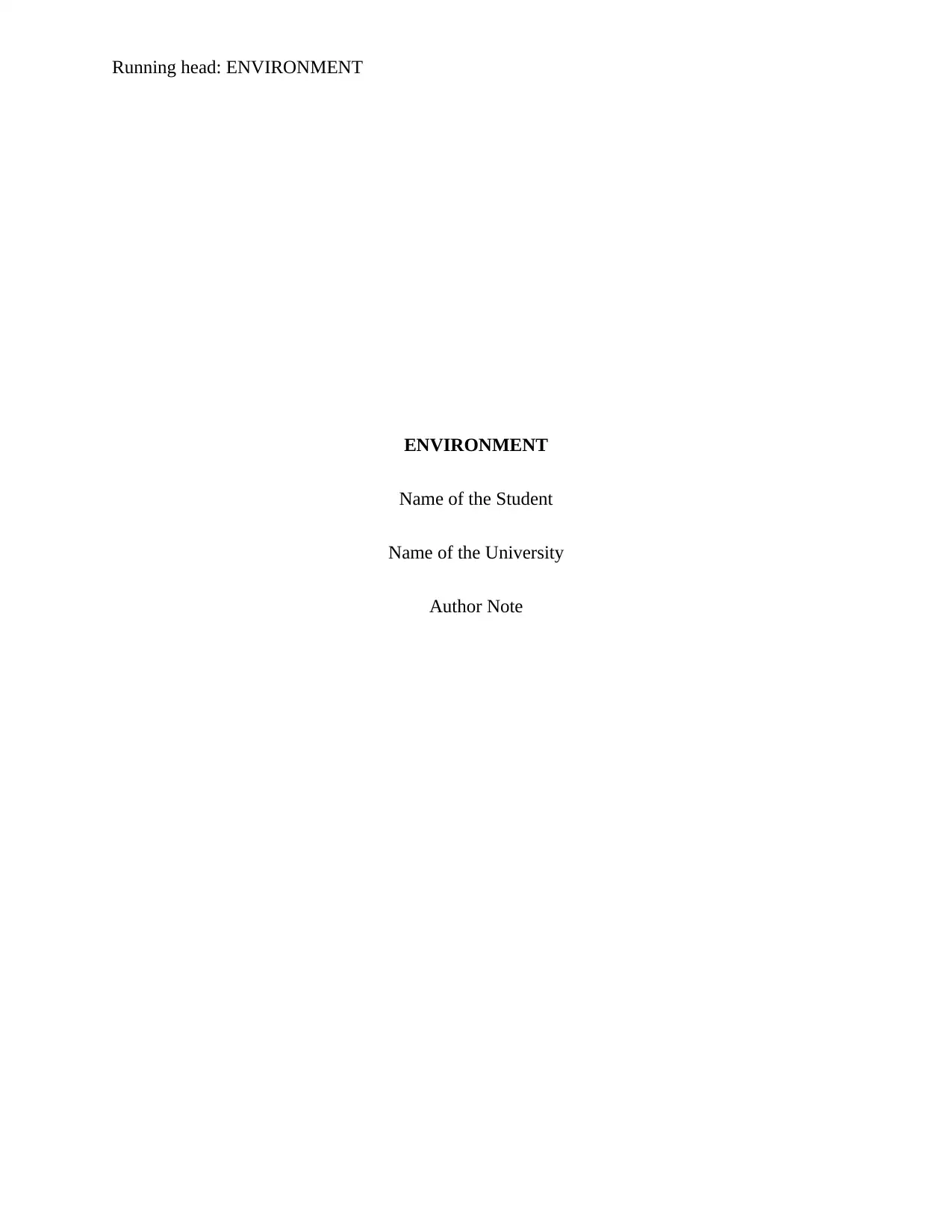
Running head: ENVIRONMENT
ENVIRONMENT
Name of the Student
Name of the University
Author Note
ENVIRONMENT
Name of the Student
Name of the University
Author Note
Paraphrase This Document
Need a fresh take? Get an instant paraphrase of this document with our AI Paraphraser
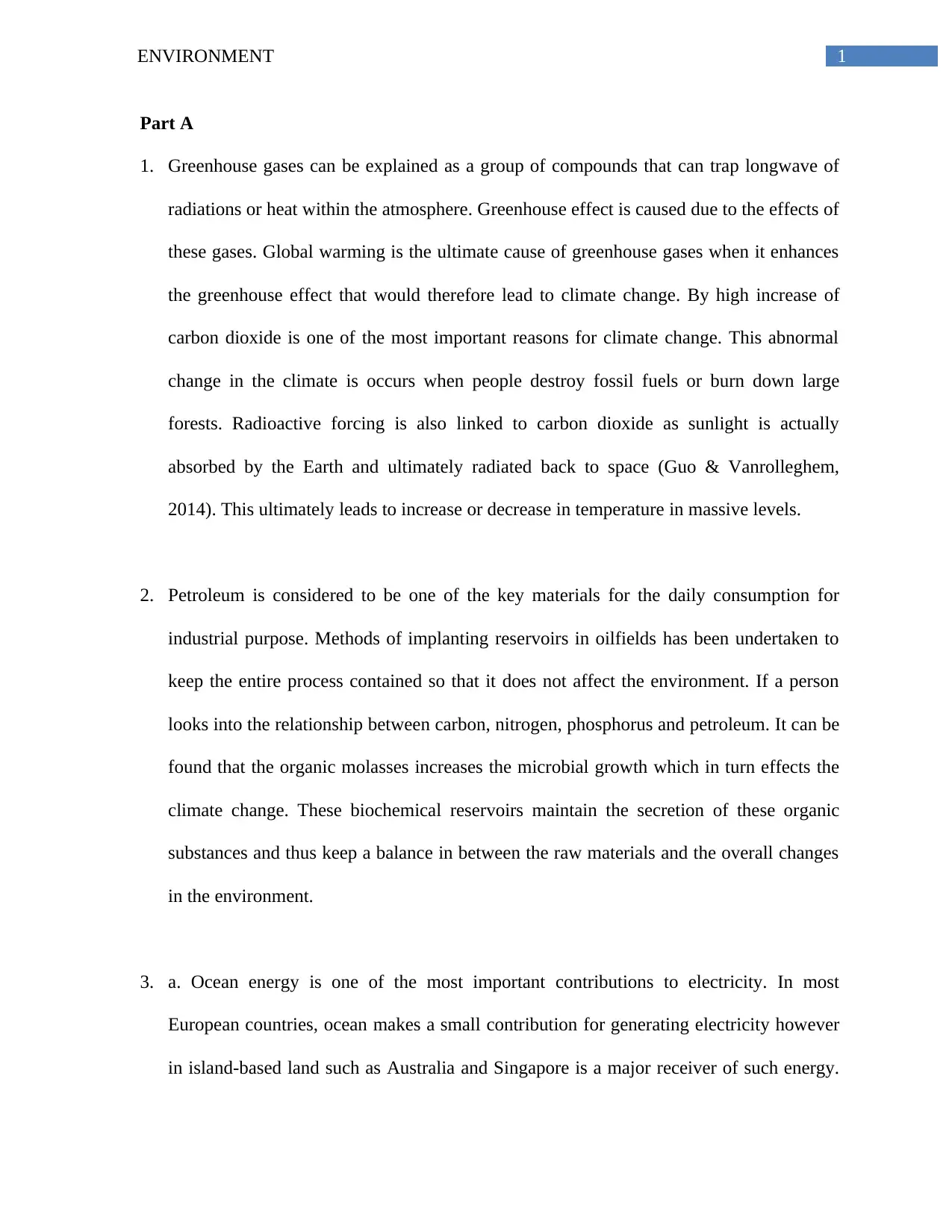
1ENVIRONMENT
Part A
1. Greenhouse gases can be explained as a group of compounds that can trap longwave of
radiations or heat within the atmosphere. Greenhouse effect is caused due to the effects of
these gases. Global warming is the ultimate cause of greenhouse gases when it enhances
the greenhouse effect that would therefore lead to climate change. By high increase of
carbon dioxide is one of the most important reasons for climate change. This abnormal
change in the climate is occurs when people destroy fossil fuels or burn down large
forests. Radioactive forcing is also linked to carbon dioxide as sunlight is actually
absorbed by the Earth and ultimately radiated back to space (Guo & Vanrolleghem,
2014). This ultimately leads to increase or decrease in temperature in massive levels.
2. Petroleum is considered to be one of the key materials for the daily consumption for
industrial purpose. Methods of implanting reservoirs in oilfields has been undertaken to
keep the entire process contained so that it does not affect the environment. If a person
looks into the relationship between carbon, nitrogen, phosphorus and petroleum. It can be
found that the organic molasses increases the microbial growth which in turn effects the
climate change. These biochemical reservoirs maintain the secretion of these organic
substances and thus keep a balance in between the raw materials and the overall changes
in the environment.
3. a. Ocean energy is one of the most important contributions to electricity. In most
European countries, ocean makes a small contribution for generating electricity however
in island-based land such as Australia and Singapore is a major receiver of such energy.
Part A
1. Greenhouse gases can be explained as a group of compounds that can trap longwave of
radiations or heat within the atmosphere. Greenhouse effect is caused due to the effects of
these gases. Global warming is the ultimate cause of greenhouse gases when it enhances
the greenhouse effect that would therefore lead to climate change. By high increase of
carbon dioxide is one of the most important reasons for climate change. This abnormal
change in the climate is occurs when people destroy fossil fuels or burn down large
forests. Radioactive forcing is also linked to carbon dioxide as sunlight is actually
absorbed by the Earth and ultimately radiated back to space (Guo & Vanrolleghem,
2014). This ultimately leads to increase or decrease in temperature in massive levels.
2. Petroleum is considered to be one of the key materials for the daily consumption for
industrial purpose. Methods of implanting reservoirs in oilfields has been undertaken to
keep the entire process contained so that it does not affect the environment. If a person
looks into the relationship between carbon, nitrogen, phosphorus and petroleum. It can be
found that the organic molasses increases the microbial growth which in turn effects the
climate change. These biochemical reservoirs maintain the secretion of these organic
substances and thus keep a balance in between the raw materials and the overall changes
in the environment.
3. a. Ocean energy is one of the most important contributions to electricity. In most
European countries, ocean makes a small contribution for generating electricity however
in island-based land such as Australia and Singapore is a major receiver of such energy.
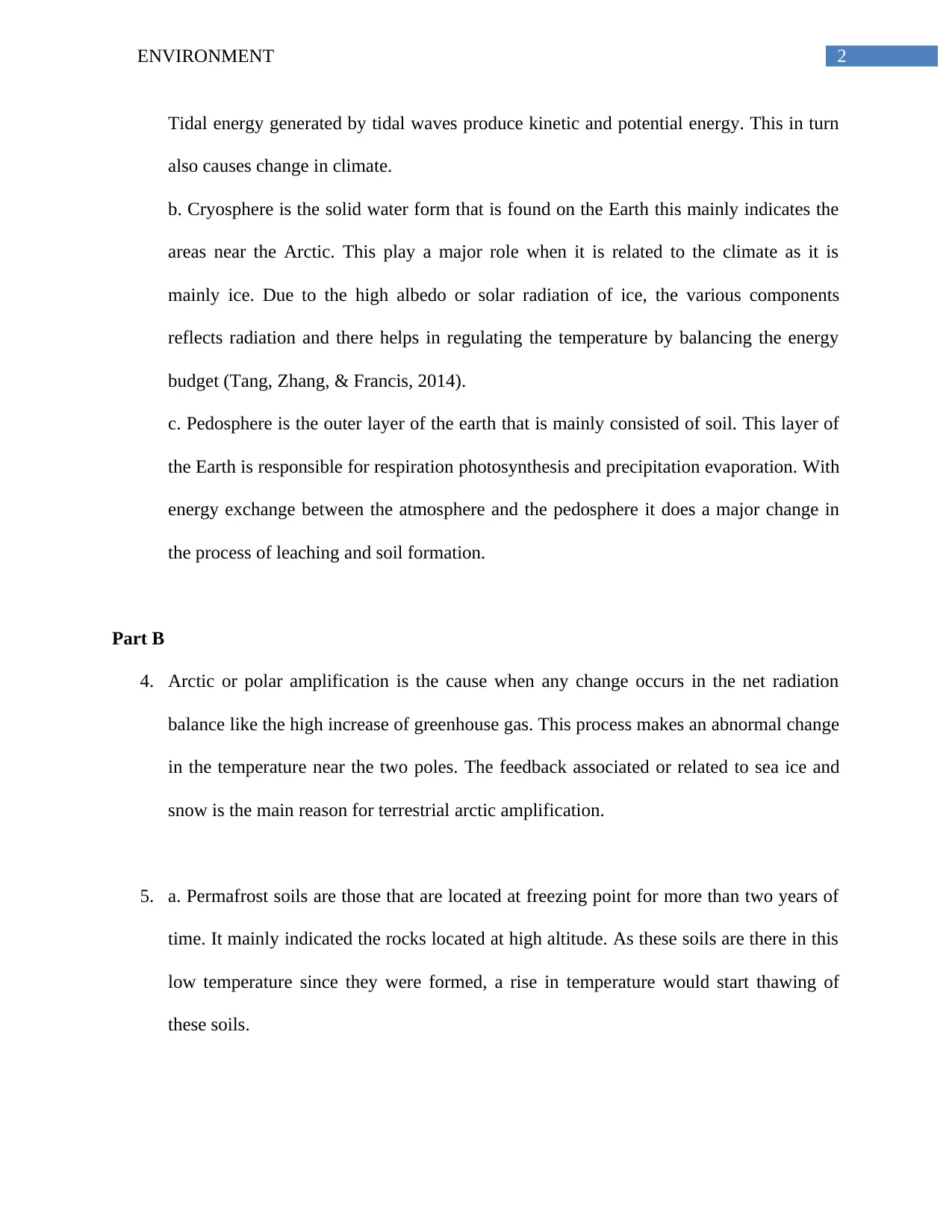
2ENVIRONMENT
Tidal energy generated by tidal waves produce kinetic and potential energy. This in turn
also causes change in climate.
b. Cryosphere is the solid water form that is found on the Earth this mainly indicates the
areas near the Arctic. This play a major role when it is related to the climate as it is
mainly ice. Due to the high albedo or solar radiation of ice, the various components
reflects radiation and there helps in regulating the temperature by balancing the energy
budget (Tang, Zhang, & Francis, 2014).
c. Pedosphere is the outer layer of the earth that is mainly consisted of soil. This layer of
the Earth is responsible for respiration photosynthesis and precipitation evaporation. With
energy exchange between the atmosphere and the pedosphere it does a major change in
the process of leaching and soil formation.
Part B
4. Arctic or polar amplification is the cause when any change occurs in the net radiation
balance like the high increase of greenhouse gas. This process makes an abnormal change
in the temperature near the two poles. The feedback associated or related to sea ice and
snow is the main reason for terrestrial arctic amplification.
5. a. Permafrost soils are those that are located at freezing point for more than two years of
time. It mainly indicated the rocks located at high altitude. As these soils are there in this
low temperature since they were formed, a rise in temperature would start thawing of
these soils.
Tidal energy generated by tidal waves produce kinetic and potential energy. This in turn
also causes change in climate.
b. Cryosphere is the solid water form that is found on the Earth this mainly indicates the
areas near the Arctic. This play a major role when it is related to the climate as it is
mainly ice. Due to the high albedo or solar radiation of ice, the various components
reflects radiation and there helps in regulating the temperature by balancing the energy
budget (Tang, Zhang, & Francis, 2014).
c. Pedosphere is the outer layer of the earth that is mainly consisted of soil. This layer of
the Earth is responsible for respiration photosynthesis and precipitation evaporation. With
energy exchange between the atmosphere and the pedosphere it does a major change in
the process of leaching and soil formation.
Part B
4. Arctic or polar amplification is the cause when any change occurs in the net radiation
balance like the high increase of greenhouse gas. This process makes an abnormal change
in the temperature near the two poles. The feedback associated or related to sea ice and
snow is the main reason for terrestrial arctic amplification.
5. a. Permafrost soils are those that are located at freezing point for more than two years of
time. It mainly indicated the rocks located at high altitude. As these soils are there in this
low temperature since they were formed, a rise in temperature would start thawing of
these soils.
⊘ This is a preview!⊘
Do you want full access?
Subscribe today to unlock all pages.

Trusted by 1+ million students worldwide
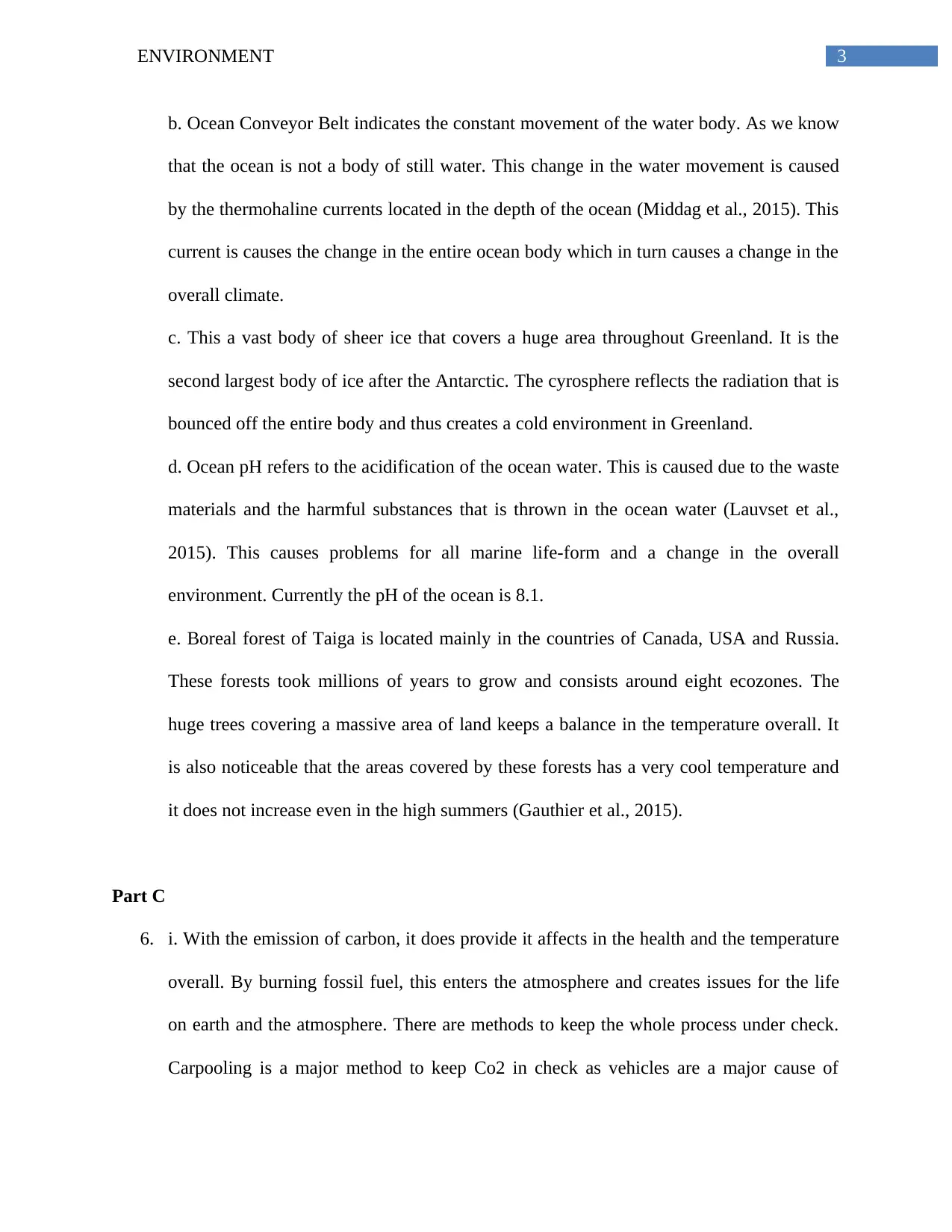
3ENVIRONMENT
b. Ocean Conveyor Belt indicates the constant movement of the water body. As we know
that the ocean is not a body of still water. This change in the water movement is caused
by the thermohaline currents located in the depth of the ocean (Middag et al., 2015). This
current is causes the change in the entire ocean body which in turn causes a change in the
overall climate.
c. This a vast body of sheer ice that covers a huge area throughout Greenland. It is the
second largest body of ice after the Antarctic. The cyrosphere reflects the radiation that is
bounced off the entire body and thus creates a cold environment in Greenland.
d. Ocean pH refers to the acidification of the ocean water. This is caused due to the waste
materials and the harmful substances that is thrown in the ocean water (Lauvset et al.,
2015). This causes problems for all marine life-form and a change in the overall
environment. Currently the pH of the ocean is 8.1.
e. Boreal forest of Taiga is located mainly in the countries of Canada, USA and Russia.
These forests took millions of years to grow and consists around eight ecozones. The
huge trees covering a massive area of land keeps a balance in the temperature overall. It
is also noticeable that the areas covered by these forests has a very cool temperature and
it does not increase even in the high summers (Gauthier et al., 2015).
Part C
6. i. With the emission of carbon, it does provide it affects in the health and the temperature
overall. By burning fossil fuel, this enters the atmosphere and creates issues for the life
on earth and the atmosphere. There are methods to keep the whole process under check.
Carpooling is a major method to keep Co2 in check as vehicles are a major cause of
b. Ocean Conveyor Belt indicates the constant movement of the water body. As we know
that the ocean is not a body of still water. This change in the water movement is caused
by the thermohaline currents located in the depth of the ocean (Middag et al., 2015). This
current is causes the change in the entire ocean body which in turn causes a change in the
overall climate.
c. This a vast body of sheer ice that covers a huge area throughout Greenland. It is the
second largest body of ice after the Antarctic. The cyrosphere reflects the radiation that is
bounced off the entire body and thus creates a cold environment in Greenland.
d. Ocean pH refers to the acidification of the ocean water. This is caused due to the waste
materials and the harmful substances that is thrown in the ocean water (Lauvset et al.,
2015). This causes problems for all marine life-form and a change in the overall
environment. Currently the pH of the ocean is 8.1.
e. Boreal forest of Taiga is located mainly in the countries of Canada, USA and Russia.
These forests took millions of years to grow and consists around eight ecozones. The
huge trees covering a massive area of land keeps a balance in the temperature overall. It
is also noticeable that the areas covered by these forests has a very cool temperature and
it does not increase even in the high summers (Gauthier et al., 2015).
Part C
6. i. With the emission of carbon, it does provide it affects in the health and the temperature
overall. By burning fossil fuel, this enters the atmosphere and creates issues for the life
on earth and the atmosphere. There are methods to keep the whole process under check.
Carpooling is a major method to keep Co2 in check as vehicles are a major cause of
Paraphrase This Document
Need a fresh take? Get an instant paraphrase of this document with our AI Paraphraser
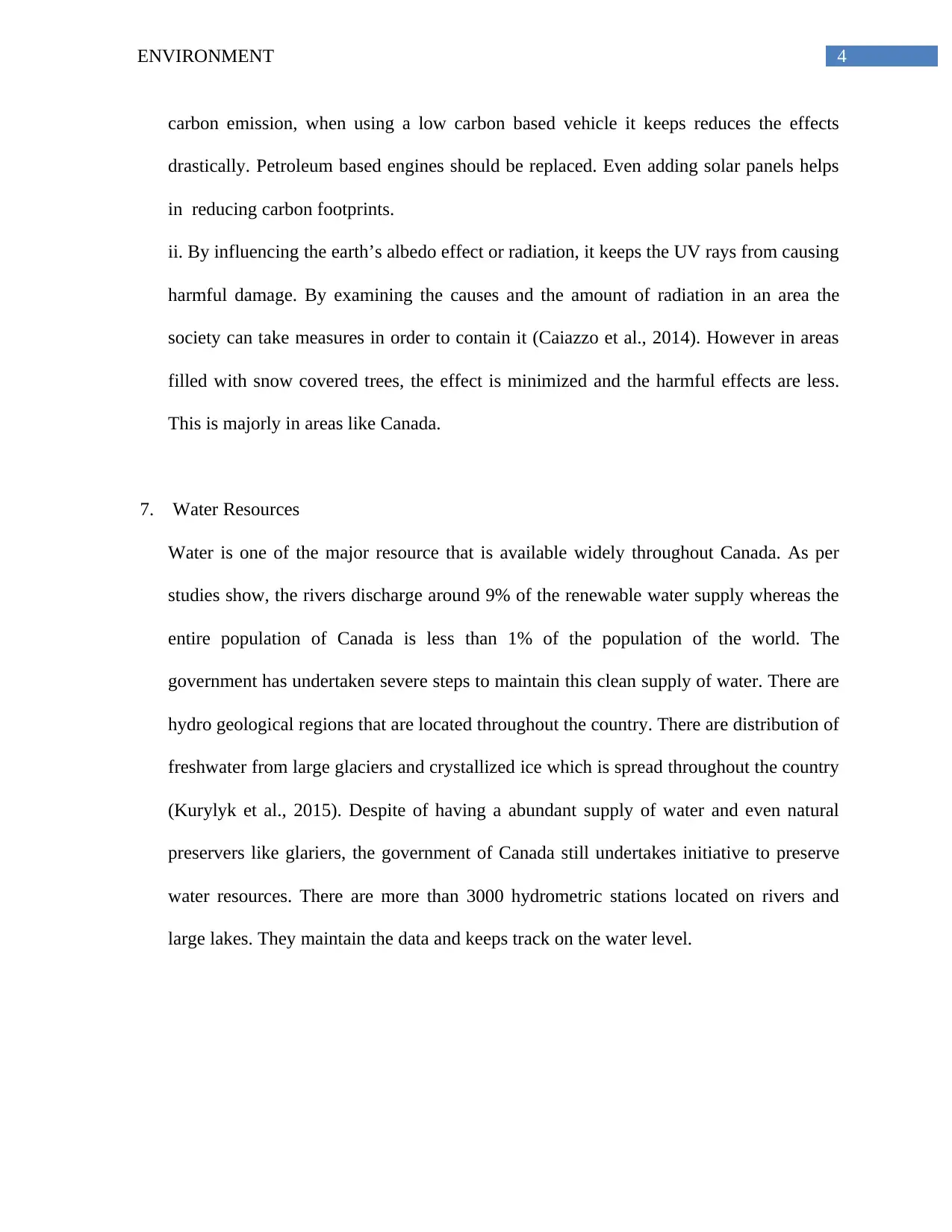
4ENVIRONMENT
carbon emission, when using a low carbon based vehicle it keeps reduces the effects
drastically. Petroleum based engines should be replaced. Even adding solar panels helps
in reducing carbon footprints.
ii. By influencing the earth’s albedo effect or radiation, it keeps the UV rays from causing
harmful damage. By examining the causes and the amount of radiation in an area the
society can take measures in order to contain it (Caiazzo et al., 2014). However in areas
filled with snow covered trees, the effect is minimized and the harmful effects are less.
This is majorly in areas like Canada.
7. Water Resources
Water is one of the major resource that is available widely throughout Canada. As per
studies show, the rivers discharge around 9% of the renewable water supply whereas the
entire population of Canada is less than 1% of the population of the world. The
government has undertaken severe steps to maintain this clean supply of water. There are
hydro geological regions that are located throughout the country. There are distribution of
freshwater from large glaciers and crystallized ice which is spread throughout the country
(Kurylyk et al., 2015). Despite of having a abundant supply of water and even natural
preservers like glariers, the government of Canada still undertakes initiative to preserve
water resources. There are more than 3000 hydrometric stations located on rivers and
large lakes. They maintain the data and keeps track on the water level.
carbon emission, when using a low carbon based vehicle it keeps reduces the effects
drastically. Petroleum based engines should be replaced. Even adding solar panels helps
in reducing carbon footprints.
ii. By influencing the earth’s albedo effect or radiation, it keeps the UV rays from causing
harmful damage. By examining the causes and the amount of radiation in an area the
society can take measures in order to contain it (Caiazzo et al., 2014). However in areas
filled with snow covered trees, the effect is minimized and the harmful effects are less.
This is majorly in areas like Canada.
7. Water Resources
Water is one of the major resource that is available widely throughout Canada. As per
studies show, the rivers discharge around 9% of the renewable water supply whereas the
entire population of Canada is less than 1% of the population of the world. The
government has undertaken severe steps to maintain this clean supply of water. There are
hydro geological regions that are located throughout the country. There are distribution of
freshwater from large glaciers and crystallized ice which is spread throughout the country
(Kurylyk et al., 2015). Despite of having a abundant supply of water and even natural
preservers like glariers, the government of Canada still undertakes initiative to preserve
water resources. There are more than 3000 hydrometric stations located on rivers and
large lakes. They maintain the data and keeps track on the water level.
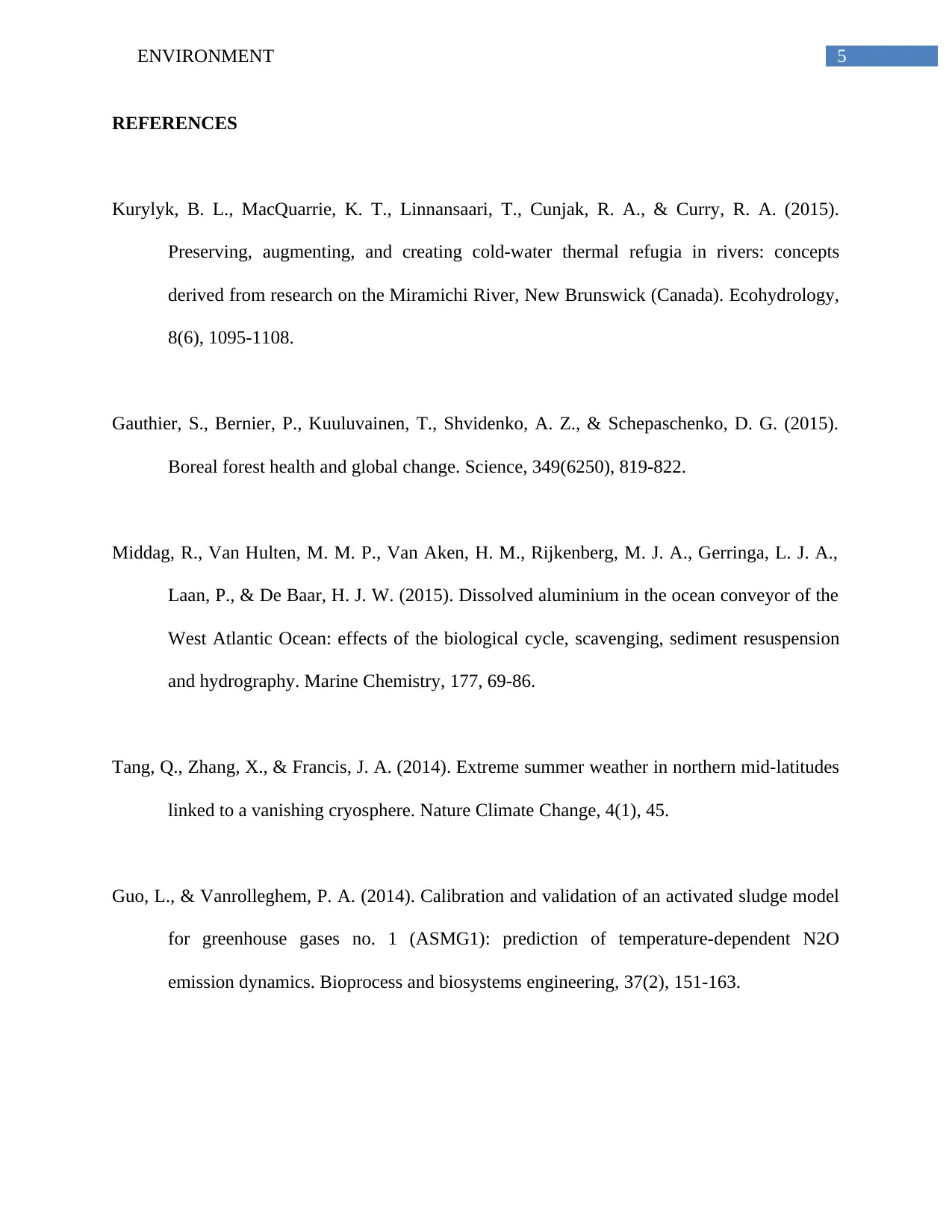
5ENVIRONMENT
REFERENCES
Kurylyk, B. L., MacQuarrie, K. T., Linnansaari, T., Cunjak, R. A., & Curry, R. A. (2015).
Preserving, augmenting, and creating cold‐water thermal refugia in rivers: concepts
derived from research on the Miramichi River, New Brunswick (Canada). Ecohydrology,
8(6), 1095-1108.
Gauthier, S., Bernier, P., Kuuluvainen, T., Shvidenko, A. Z., & Schepaschenko, D. G. (2015).
Boreal forest health and global change. Science, 349(6250), 819-822.
Middag, R., Van Hulten, M. M. P., Van Aken, H. M., Rijkenberg, M. J. A., Gerringa, L. J. A.,
Laan, P., & De Baar, H. J. W. (2015). Dissolved aluminium in the ocean conveyor of the
West Atlantic Ocean: effects of the biological cycle, scavenging, sediment resuspension
and hydrography. Marine Chemistry, 177, 69-86.
Tang, Q., Zhang, X., & Francis, J. A. (2014). Extreme summer weather in northern mid-latitudes
linked to a vanishing cryosphere. Nature Climate Change, 4(1), 45.
Guo, L., & Vanrolleghem, P. A. (2014). Calibration and validation of an activated sludge model
for greenhouse gases no. 1 (ASMG1): prediction of temperature-dependent N2O
emission dynamics. Bioprocess and biosystems engineering, 37(2), 151-163.
REFERENCES
Kurylyk, B. L., MacQuarrie, K. T., Linnansaari, T., Cunjak, R. A., & Curry, R. A. (2015).
Preserving, augmenting, and creating cold‐water thermal refugia in rivers: concepts
derived from research on the Miramichi River, New Brunswick (Canada). Ecohydrology,
8(6), 1095-1108.
Gauthier, S., Bernier, P., Kuuluvainen, T., Shvidenko, A. Z., & Schepaschenko, D. G. (2015).
Boreal forest health and global change. Science, 349(6250), 819-822.
Middag, R., Van Hulten, M. M. P., Van Aken, H. M., Rijkenberg, M. J. A., Gerringa, L. J. A.,
Laan, P., & De Baar, H. J. W. (2015). Dissolved aluminium in the ocean conveyor of the
West Atlantic Ocean: effects of the biological cycle, scavenging, sediment resuspension
and hydrography. Marine Chemistry, 177, 69-86.
Tang, Q., Zhang, X., & Francis, J. A. (2014). Extreme summer weather in northern mid-latitudes
linked to a vanishing cryosphere. Nature Climate Change, 4(1), 45.
Guo, L., & Vanrolleghem, P. A. (2014). Calibration and validation of an activated sludge model
for greenhouse gases no. 1 (ASMG1): prediction of temperature-dependent N2O
emission dynamics. Bioprocess and biosystems engineering, 37(2), 151-163.
⊘ This is a preview!⊘
Do you want full access?
Subscribe today to unlock all pages.

Trusted by 1+ million students worldwide
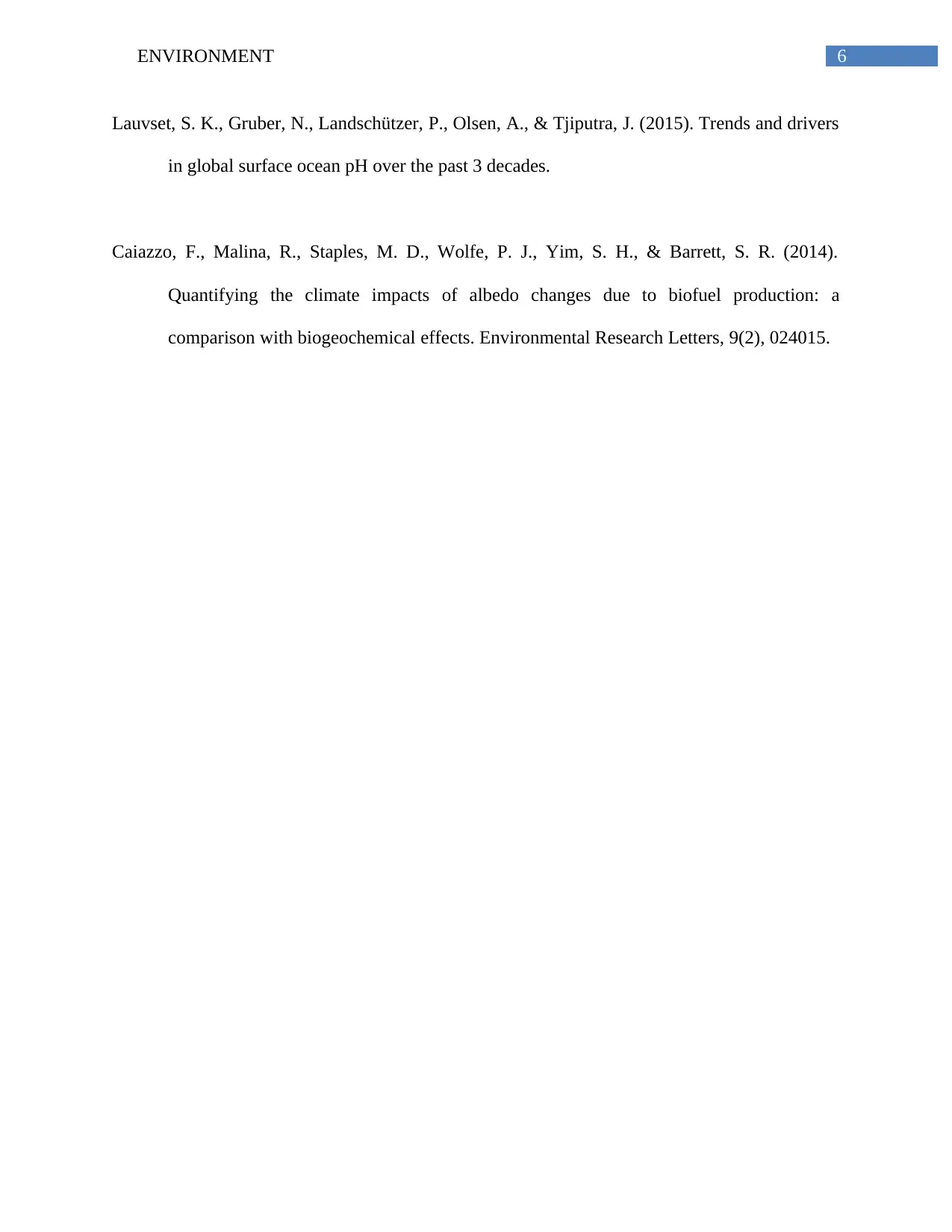
6ENVIRONMENT
Lauvset, S. K., Gruber, N., Landschützer, P., Olsen, A., & Tjiputra, J. (2015). Trends and drivers
in global surface ocean pH over the past 3 decades.
Caiazzo, F., Malina, R., Staples, M. D., Wolfe, P. J., Yim, S. H., & Barrett, S. R. (2014).
Quantifying the climate impacts of albedo changes due to biofuel production: a
comparison with biogeochemical effects. Environmental Research Letters, 9(2), 024015.
Lauvset, S. K., Gruber, N., Landschützer, P., Olsen, A., & Tjiputra, J. (2015). Trends and drivers
in global surface ocean pH over the past 3 decades.
Caiazzo, F., Malina, R., Staples, M. D., Wolfe, P. J., Yim, S. H., & Barrett, S. R. (2014).
Quantifying the climate impacts of albedo changes due to biofuel production: a
comparison with biogeochemical effects. Environmental Research Letters, 9(2), 024015.
1 out of 7
Related Documents
Your All-in-One AI-Powered Toolkit for Academic Success.
+13062052269
info@desklib.com
Available 24*7 on WhatsApp / Email
![[object Object]](/_next/static/media/star-bottom.7253800d.svg)
Unlock your academic potential
Copyright © 2020–2025 A2Z Services. All Rights Reserved. Developed and managed by ZUCOL.



